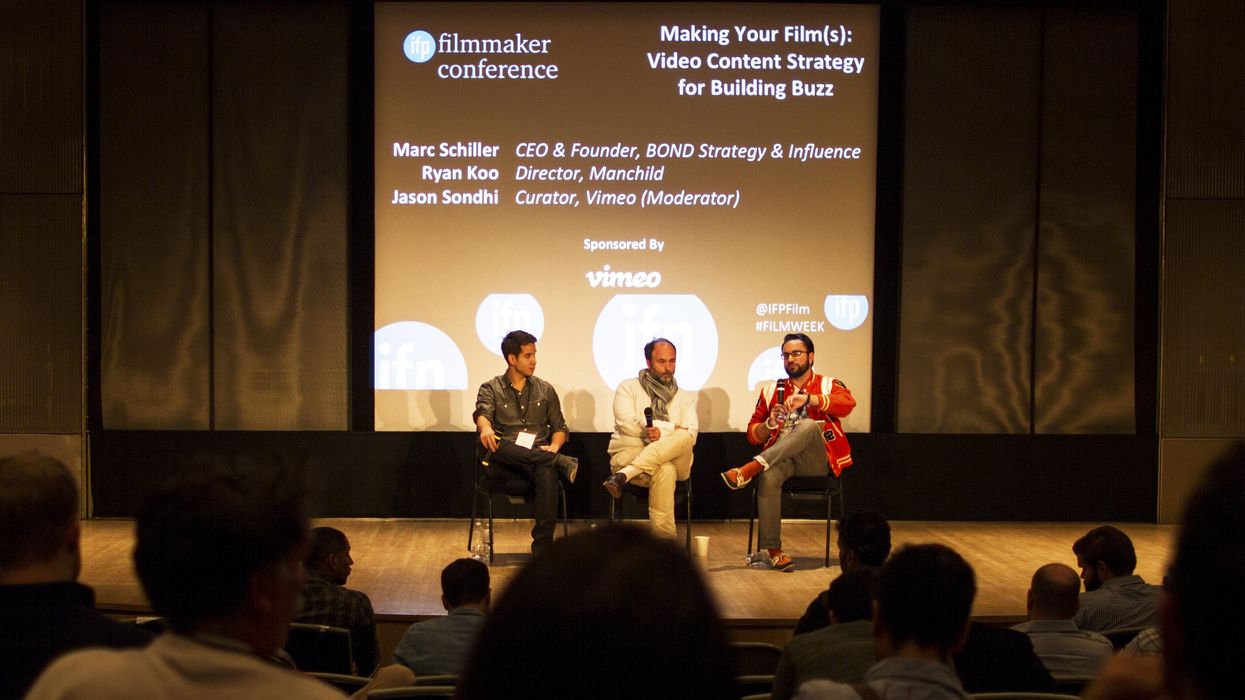IFP Film Week: Top Strategies for Building Buzz with Online Content

IFP Film Week delivered the lowdown on building audience buzz with online video from CEO/Founder of BOND Strategy & Influence Marc Schiller,Creative Director of Film & Video at Vimeo Jeremy Boxer, and some guy named Ryan Koo. I guarantee you haven't heard all of these tips before (and if you have, I'll hire you to be my Social Media Manager.) So, it's a win-win. Read on for some great marketing advice that may help you to garner attention for your project.
Marc Schiller's BOND Strategy & Influence has supported a formidable array of projects, including Exit Through the Gift Shop, Marley, and Cutie and the Boxer. Besides working as Creative Director and Festival Director at Vimeo, Jeremy Boxer has worked with clients ranging from the Tribeca Film Festival to Nike and PlayStation. Ryan Koo, well -- if you don't know who he is, check out the "About" section to your right. Let's get to their key advice for building your film's audience with online content:
Release your video content selectively
Choose around 6 short clips to give online audiences a taste of the tonality of your film. Release a total length of less than 10 minutes online, as per academy rules. Pick scenes that represent not the film you know you made, but the audience you want to expose your film to. They're not always the same.
Awareness is critical
The number one reason a potential fan won't see your movie is because they don't know it exists. Video can be a great tool to spread awareness. Create a frequent sequence of extra content that audiences can subscribe to. Create video content to keep audience engaged both before and after seeing the movie.
Make room in your budget ahead of time for extra content
Because you never know how it might come in handy. Eugene Jarecki of The House I Live In cut 5 minute segments as 'drug war dispatches,' planning to give them away for free online. Instead, he and Schiller developed a Netflix Exclusive out of the content. In any case, extra content sustains audience interest and builds loyalty. Update audiences, revisit storylines and characters, and make room in your production to accommodate that. Own the data, and bring it to your community directly.
The trailer is the most important video asset you will ever have
You don't really know the film you have until you see it with an audience of strangers. Do not cut your own trailer before you've done this; you need to know what moves objective audiences. It probably won't be the same as what moves you.
Collect email addresses
Email is the best marketing tool, hands down. In terms of getting people to watch your film and to act, there is nothing better than email. A loyal audience can also make a big difference in a career. You can literally sell out a weekend in the IFC Center if you have a good mailing list. It's not quantity, it's quality. Collect email addresses at live screenings and on the web. Use free giveaways to attract your audience. Get a free Mailchimp account and reach out to 2,000 subscribers for free.
Define your positioning
How do you talk about your film? That's your opportunity to establish why the film should matter to both niche and general audiences.
Select incredible stills
Google image search makes your movie stills ubiquitous from the beginning. Most independent films don't have a photographer taking beautiful stills on set every day, so very lazy photography tends to get out before the curated images. Choose photos that pull you in. Your sales agent or distributor won't do this as well retroactively as you can during the moment.
When cold emails go nowhere, use the back door
Ask yourself, "Who do I know who knows somebody who knows somebody?" Pick up the phone.
Utilize the power of the story of the creation of your film
Often people will connect with you more easily than connecting directly with the narrative of the film. Get your own story out there.
Barter exclusive video content for exposure
If you don't have enough money for a massive PR campaign, use exclusivity to lure partners like IMDb and Hulu to prominently feature your content. This strategy doesn't build community or loyalty, but it builds exposure.
Experiment
Everything is not so precious. If an idea fails, the community is likely fine with that. Being flawed shows that you're not a marketer. It shows you're human.
Helpful? Any more key advice from the social media moguls out there?











